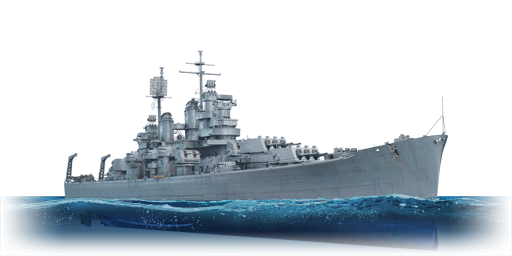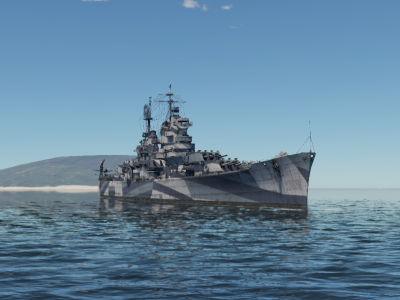The USS Baltimore was the lead ship of the Baltimore-class heavy cruisers built for the US Navy in the 1940s. She was laid down on 26th May 1941 and commissioned on 15th April 1943. The design was influenced by the Cleveland-class light cruisers, which the Baltimores were enlarged and more heavily armed versions of. Main armament was made up of three triple 8-inch cannons supported by six twin dual-purpose 5-inch guns alongside the hull. As one of the Baltimore-class' duties was anti-aircraft protection of the task force, Baltimore was armed with twelve quadruple 40 mm Bofors anti-aircraft guns further complemented by twenty-four single mounted 20 mm Oerlikon Mk. II autocannons. Between November 1943 and June 1944, Baltimore provided shore bombardment and fire support to invasion forces on various atolls and islands of the Pacific such as Makin Island, Kwajalein, and Eniwetok. She also took part in the Marianas campaign and landings on Saipan and the Philippines. In 1945, she provided fire support for US troops landing on Okinawa and Iwo Jima. Between November 1945 and February 1946, she was part of the occupation fleet in Japan, until she was placed in reserve on 8th July 1946. She was recommissioned on 28th November 1951 and sailed to the Mediterranean where she was part of the Sixth Fleet, conducting exercises and training until 1955 when she was transferred to the Seventh Fleet in the Far East. She was decommissioned on 31st May 1956 and sold for scrap on 10th April 1972.
It was introduced during Update "Hot Tracks" as a reward for the 2020 Operation W.I.N.T.E.R. event.
The Baltimore-class heavy cruisers represent the zenith of the United States Navy "screening fleet" doctrine during World War II. The ships of this class feature a variety of gun calibres placed all over the ship, with the emphasis on providing anti-air defense to fleet carriers taken to another level. The USS Baltimore, the lead ship of the class, features a very high amount of anti-air armaments amongst cruisers with 72 in total. This huge amount of guns (consisting of powerful 40 mm Bofors and 20 mm Oerlikon autocannons) will keep all but the most daring of enemy aircraft at bay. Her anti-ship firepower is also not to be underestimated, as she features nine 8 inch (203 mm) cannons with super-heavy APCBC shells and versatile 127 mm secondary turrets. This makes the Baltimore a force to be reckoned with, even in top rank naval battles.













